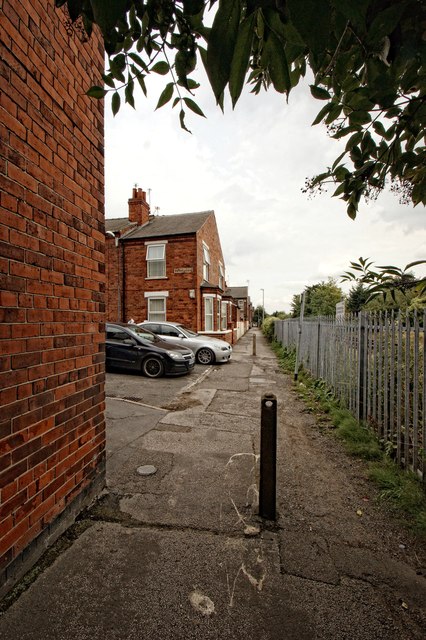Spa Street to Devon Street, Lincoln - Hartley Street
Introduction
The photograph on this page of Spa Street to Devon Street, Lincoln - Hartley Street by Dave Hitchborne as part of the Geograph project.
The Geograph project started in 2005 with the aim of publishing, organising and preserving representative images for every square kilometre of Great Britain, Ireland and the Isle of Man.
There are currently over 7.5m images from over 14,400 individuals and you can help contribute to the project by visiting https://www.geograph.org.uk

Image: © Dave Hitchborne Taken: 28 Aug 2013
Between the railway and Monks Road are eight streets: (west to east) Spa Street, Walmer Street, Toronto Street, Hartley Street, McInnes Street, Kent Street, Dorset Street and Devon Street. Spa Street is the only through road, the rest being cul-de-sacs. The railway ends of the cul-de-sacs are linked together by a footpath to Spa Street. The end of Dorset Street appears to have had a railway underbridge connection to the former Clayton & Shuttleworth engineering works. I think it’s fair to say that all the houses were built at the same time as Clayton & Shuttleworth’s Abbey Works and Tower Works and that is during the Great War. The houses aren’t on the 1908 map, which is only eight years before the engineering works were built. I also think that they were built to house those who worked in the factories, churning out war machines. Lincoln’s involvement in the war effort, included the construction of aircraft and tanks. Some of the houses nearest the railway and works are a bit more up market than the others and may have belonged the foremen, managers, etc. Clayton & Shuttleworth’s Abbey Works and Tower Works were on the south side of the railway line. (The railway came to Lincoln in 1846.) They shared a rail connection and sidings (Abbey sidings) with other works to the west, one of which was a Tar Works. The other may have been Clayton and Shuttleworth's Electric Generating Station. Electricity first came to Lincoln in 1898 when it's electricity generating station was built, so Clayton and Shuttleworth's generating station may have been purpose built to power the workshops. I believe it was gas-fired, but need to research that fact. There is now an Electricity Sub Station, to the east of the works. The Abbey Works and Tower Works site is now occupied by Wyman-Gordon (Lincoln LTD), Metal Finishing Services, Tower Works, Spa Road. Wyman-Gordon is a company that designs and manufactures complex metal components. It was founded in 1883 (although not here as maps don't support that fact) as a manufacturer of crankshafts for looms and has a long history of making forged metal components, particularly for the aerospace industry. This plant makes forged engine discs, engine shafts, and components of airframes and landing-gear. Its main customer is Rolls-Royce. To the north-east of the houses was a tramway system, which brought stone down from the quarries to the Abbey sidings. The tramway extended to within yards of the Lincoln-Wragby road at SK995727. It no longer exists. To the south of the works runs the River Witham, which may or may not have locally played a part in the war effort.

